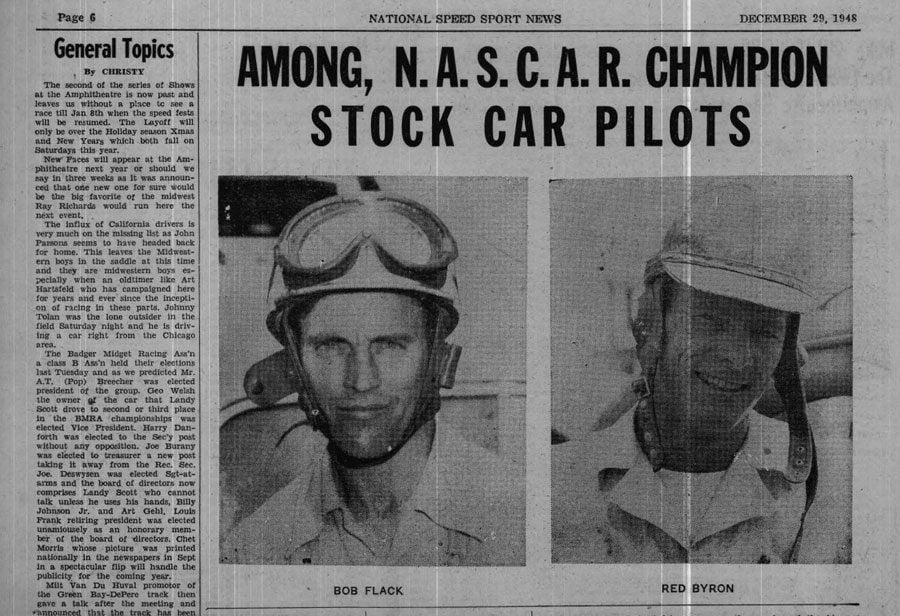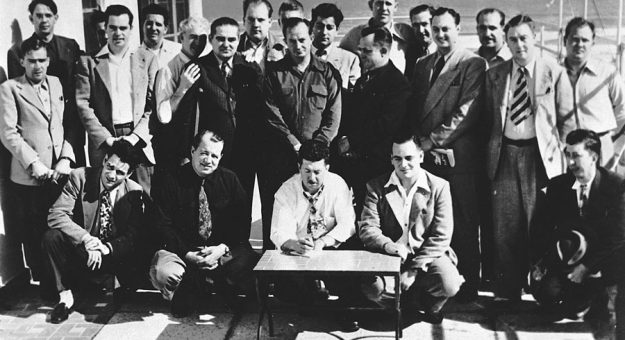NASCAR is celebrating its 75th anniversary in 2023. SPEED SPORT was founded in 1934 and was already on its way to becoming America’s Motorsports Authority when NASCAR was formed. As a result, we will bring you a 75-part series on the history of NASCAR as told in the pages of National Speed Sport News and SPEED SPORT Magazine.
The year was 1948.
Production was gearing up in this country to meet demands for housing, cars and other consumer items for the returning military personnel from World War II. The auto industry was straining to produce enough cars to satisfy a hungry group of young men and used car lots were filling up with pre-war coupes and sedans as the new models were snapped up as soon as they hit the dealerships.
It was these 1939-’41 cars that were finding their way onto the nation’s short tracks, tired of the dress parade midget shows offered by the midget boom from 1946 onward.
The traditional racing season — Easter to Labor Day — came into being at the same time the Soviet Union began its blockade of the Allied sectors of Berlin in April, 1948, which led to the building of the Berlin Wall.
Former State Department official Alger Hiss was indicted for perjury after denying he had passed secret information to Whittaker Chambers, who then passed them to a Communist spy ring. Two years later, Hiss was sentenced to five years in prison.
The Birth Of NASCAR
NASCAR came into being on Dec. 12, 1947 at the Streamline Inn in Daytona Beach, Fla.
Local race promoter Bill France gathered other racing businessmen from up and down the East Coast who had come to Florida to a stock car racing convention, to “set up a complete organization which will act as a guide to stock car racing throughout the United States,” according to the December 3, 1947, issue of NSSN.
A promoter since the late 1930s, France had seen unskilled drivers, dishonest race promoters and unsafe tracks tarnish stock car racing. His vision, shared by NASCAR’s first secretary, Bill Tuthill, was to standardize rules and regulations covering the sport to ensure equal competition, to guarantee payouts to race participants and establish a point system to crown a true national stock car champion.
Thus, the green flag waved on NASCAR’s inaugural season.
At the same time, the generation that would build America — and in turn, NASCAR — was being born in record numbers. The Baby Boomers would have a real and lasting effect on the next 50 years of American history, weaving parts of the social fabric that would knit itself into the prosperity and ease of the 1980s and 1990s.
The eighth annual Daytona Beach race, held Feb. 2, 1948, kicked off the still-fluid race schedule. In response to the flurry of publicity surrounding NASCAR’s formation, the race received more than 250 applications for entry from across the country, but after three days of qualifying, fewer than 50 cars sped over the then-2.2-mile beach road course for a share of the $3,500 purse.
Robert “Red” Byron emerged victorious and gained the early advantage in the first NASCAR championship points battle.

Robert “Red” Byron Vs. Bob Flock
Byron also grabbed a headline in qualifying for the Jacksonville (Fla.) Speedway event three weeks later. He set the half-mile record with a 27.5-second run in his No. 22 Ford V-8. France immediately announced NASCAR’s acceptance of the new qualifying record.
Byron went on to grab third in the race behind runner-up Bob Flock and his brother, Fonty, who later in the season broke Byron’s record in Winston-Salem, N.C. Fonty also became his biggest rival for the points championship.
Flock’s victory in Jacksonville was padded by triumphs in Greensboro, N.C., Martinsville, Va., and at the Daytona Beach 100-miler.
However, Byron may have been behind, but he was never out of the race. Crowns in two features at the new three-quarter-mile Charlotte Speedway vaulted him ahead of Fonty Flock in the new points count before he faded to second again just weeks later. Yet, when the points were added at the end of NASCAR’s initial season, Byron reigned as the first NASCAR points champion.
The First Race Under The Lights
In a season of firsts, several tracks opened with NASCAR-sanctioned competition as its inaugural test. Charlotte Speedway, which was described in the April 28 issue of NSSN as “the nation’s newest and fastest three-quarter-mile banked clay auto speedway,” hosted its first event July 11.
The Bill France-managed speed plant boasted ID-foot-wide turns and 80-foot-high banks. The $4,000 prize offered by the Occoneechee Speedway in Hillsboro, N.C., was “the largest (purse) in racing South of the Mason-Dixon line,” according to the June 23 issue. In Wadesboro, N.C., the new track opened by hosting the eighth race of the 1948 season.
While not a new track, Danville (Va.) Speedway held NASCAR’s first race under the lights.
Races at tracks which opened with NASCAR events were but a few of the 33 sanctioned stock car events in 1948. Georgia ovals in Atlanta, Columbus and Macon, and North Carolina plants in Greensboro, Lakeview and North Wilkesboro hosted races, all of which were in the Southeast except for a 200-miler at Langhorne (Pa.) Speedway.
Another 21 NASCAR modified stock and roadster races were promoted by the Ohio Speedway Ass’n and the Eastern States Racing Ass’n in Ohio and the Northeast for a total of 54 events. Interestingly, all but the Charlotte and Langhorne races took place on fairgrounds ovals. The Charlotte and Langhorne tracks were purpose-built for racing.
When the brakes were applied to NASCAR’s first season, Byron was driving champion, Raymond Parks was the champion car owner and Jerome “Red” Vogt was the champion mechanic.
Yet, NASCAR was still moving, literally and figuratively.
NASCAR headquarters moved from France’s longtime office at 29 Goodall Ave. to larger offices on Main St. in Daytona Beach and began its half century move into the mainstream of American sports.
